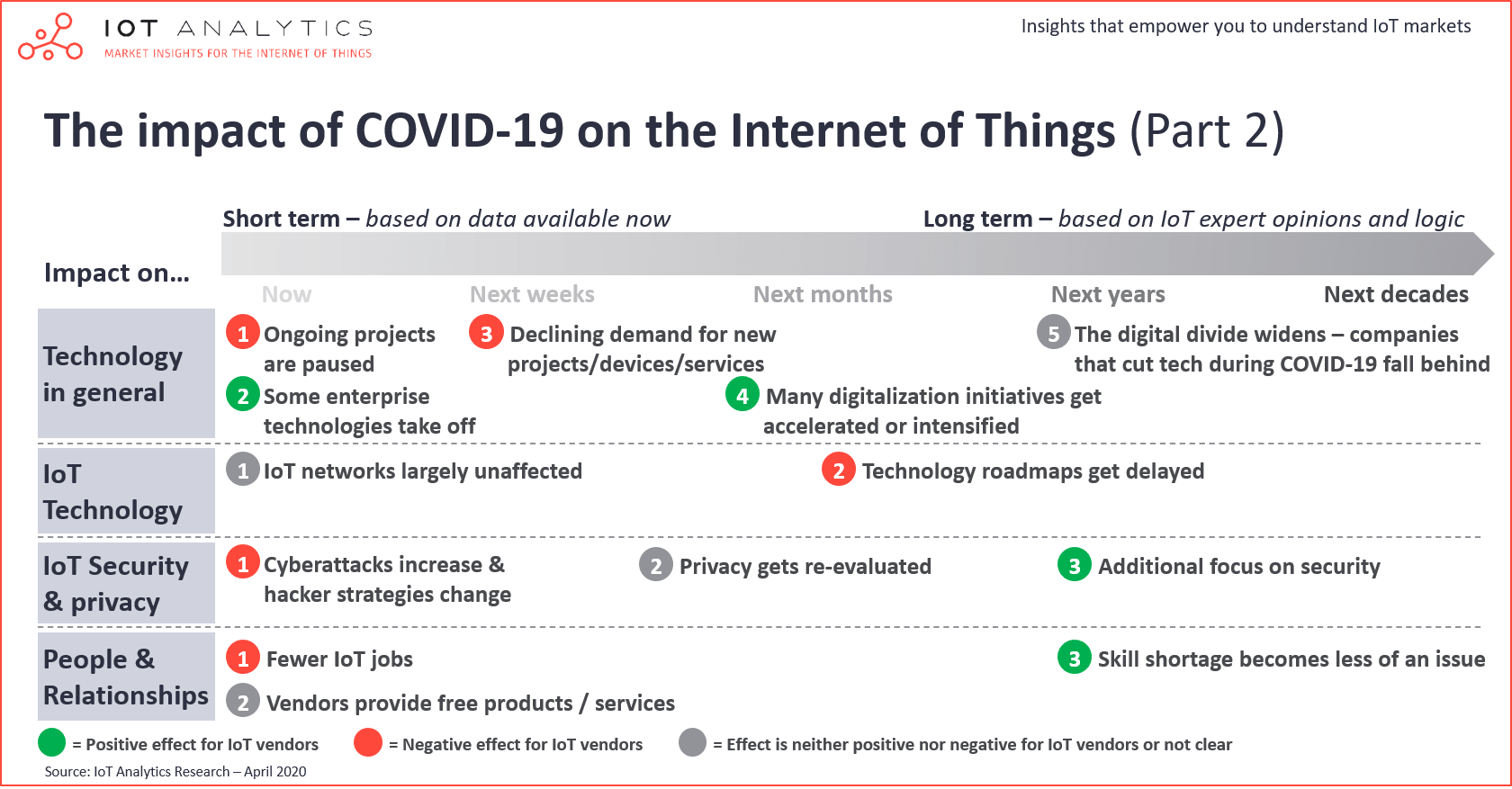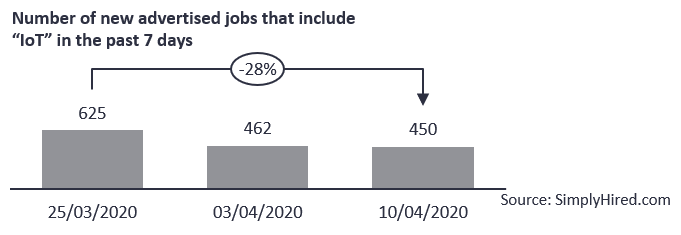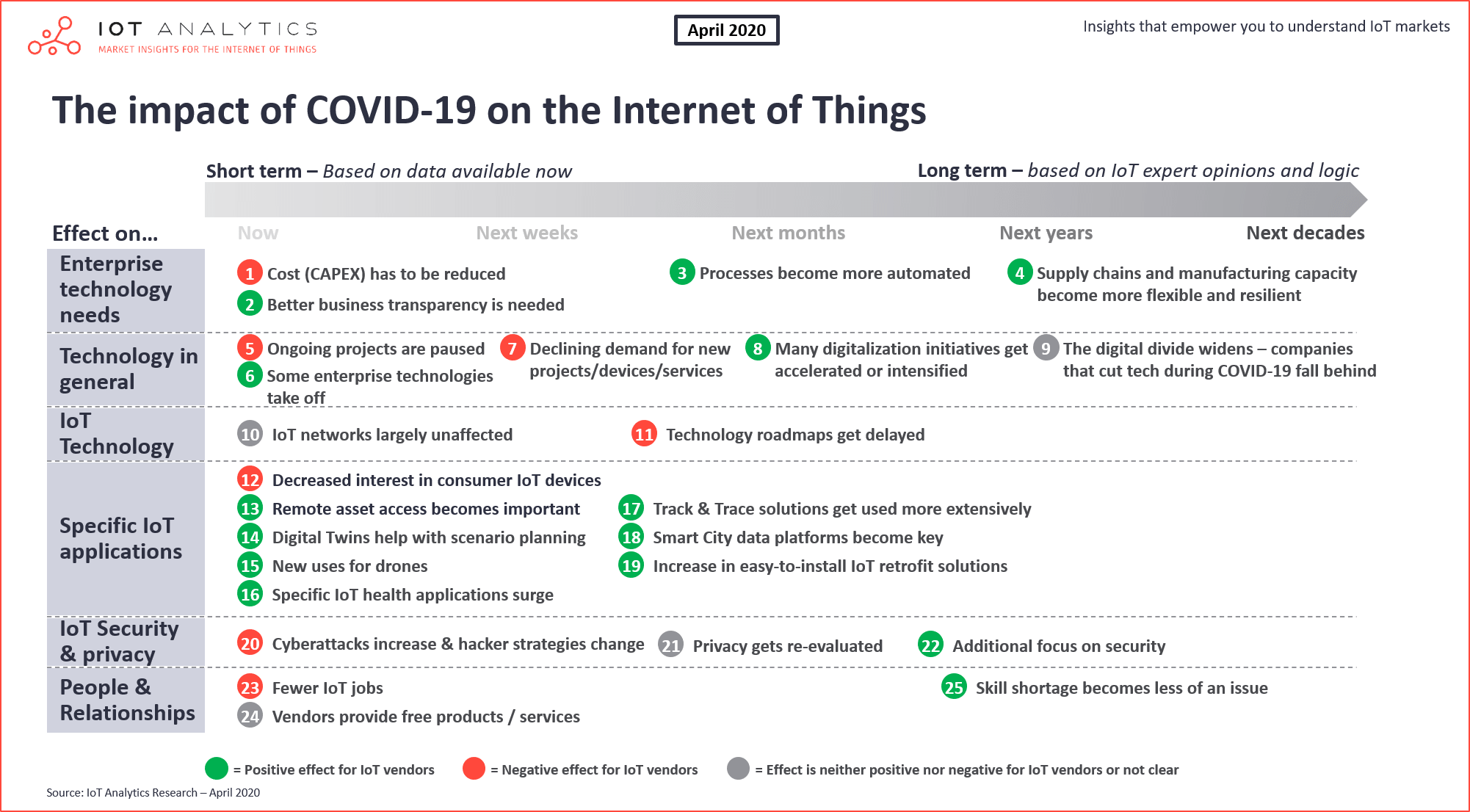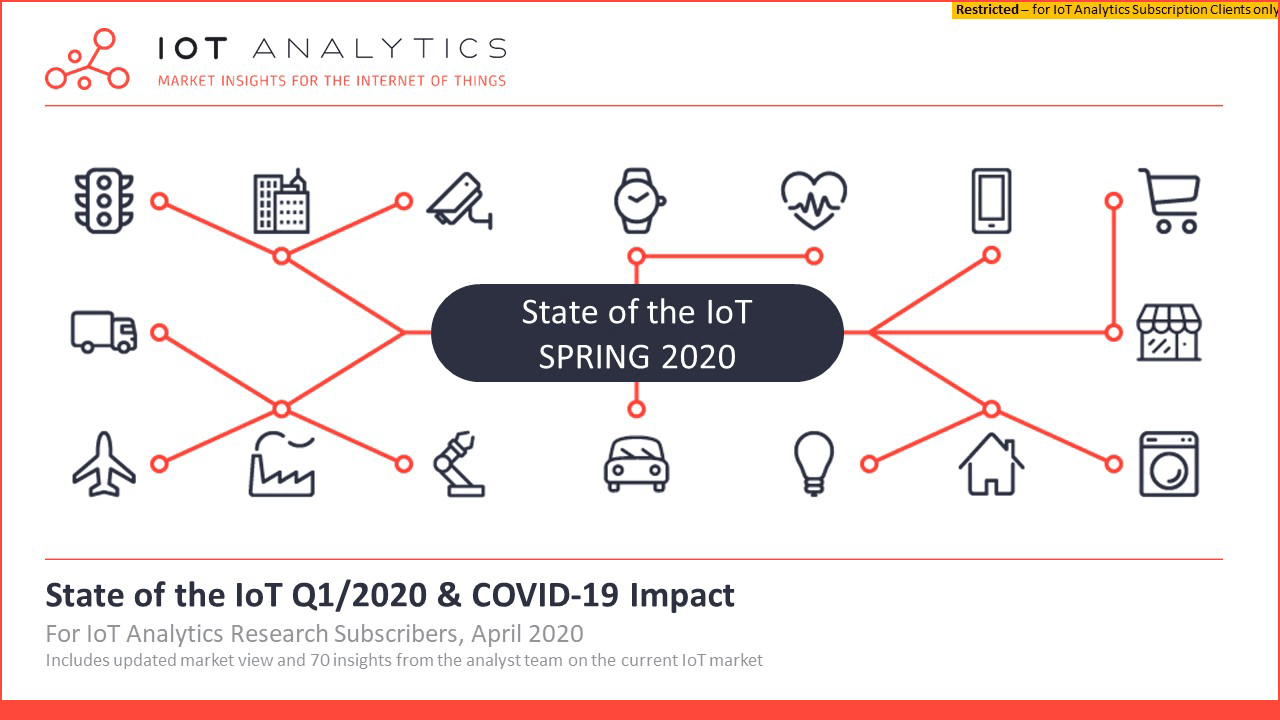Covid-19 continues to have an unprecedented impact on our society and our economy.
In Part 1 of our analysis on the “impact of Covid-19 on the Internet of Things” we highlighted how the crisis is causing companies to require more transparency, reduce Capex and reconsider supply chains.
We also discussed how IoT applications like “Track & Trace”, “Remote Asset Access” and specific healthcare use cases benefit from these shifting needs during and after the crisis.
This article is part 2 of the blog series, and it focuses on the Covid-19 technology impact, security implications and the implications on people and partnerships
The impact of Covid-19 on technology in general
Before we look at the Covid-19 technology impact for IoT, we will first explore how Covid-19 is impacting technology in general.
1. Ongoing projects are paused
The consensus opinion right now is that there is a general decline in technology budgets as many projects are put on hold or slowed down. Recent research by ETR suggests a 4% drop in budgets, although the data was assembled in the early days of the crisis.
There are two exceptions of projects that do not get paused:
- Highly strategic initiatives
- Projects involving technologies that are directly linked to COVID-19 (see next aspect)
2. Some enterprise technologies take off
There is a notable ramp-up in technologies such as
- Work-from-home infrastructure (e.g., laptops, screens, connectivity, etc.)
- Collaboration tools (e.g., ideo conferencing, team chat, project planning, etc.)
- Virtualization infrastructure (e.g., remote desktops)
- VPN networking
- Mobile devices
- Security
- Desktop support
Zoom has become the posterchild of the Covid-19 technology impact. Interest for the video conferencing solution is surging during the crisis. In March, Zoom reported 200 million daily users, up from 10 million in December 2019.
3. Declining demand for new projects/devices/ services
The sales pipelines for firms around the world are drying up as companies become more cautious about procuring new services, starting new projects or buying IoT hardware.
IoT Analytics recently talked to several people on this topic:
A Business development manager at an online marketplace for enterprise consulting projects in Europe told us in April that “In the last weeks, we have seen a drop in ~50% of new projects being advertised on our portal.”
The Head of Business Development at a cellular IoT network provider said in the last March week that:
“Our website traffic is down 20%, resulting in less conversions. Currently I expect March to reach to result in a sales decrease of ~13% compared to January.”
4. Many digitalization initiatives get accelerated or intensified
There are strong indications that the current decrease in demand for technology and digital solutions will be just a short-term phenomenon. In the medium-to-long run the Covid-19 technology impact may be extremely positive..
COVID-19, in a matter of weeks, changed both employer and employee behavior as well as working practices in firms around the world. Everyone (including the executives) is forced to embrace new technologies and discover their benefits (and challenges).
On top of that, companies will want to build more resilience in order to be better prepared in case another pandemic rattles the world. Additional investment in digital infrastructure can be expected.
A business director at an industrial communications solution provider we interviewed in April 2020 confirmed this view:
“As a provider of remote asset connectivity solutions, we are seeing increased interest in our solutions right now. Our customers and prospects are telling us that we are the first step in their digitalization and that they are planning to accelerate their digitalization initiatives now.”
5. The digital divide widens
In the long-run, Covid-19 may lead to a digital divide.
IoT Analytics has seen two extreme reactions of different companies during the current crisis. One firm that was interviewed laid off their entire digital team as one of the first cost-cutting measures. Another company cut costs elsewhere and ensured their digital initiatives would continue uninterrupted.
COVID-19 may prove to be a decisive event that further widens the digital divide between those who cut digital initiatives and those that prioritize them. Those that were just sailing along with some digital initiatives but didn’t take it too seriously, now fall behind, while others pull ahead and may find new digital business models that put them in a leading position in their industries for years to come.
The impact of Covid-19 on specific IoT technologies
1. IoT networks largely unaffected
Unlike the Internet in general, which is seeing much higher data throughput rates as people stay home and consume videos and perform teleconferences, the “Internet of Things” does not see the same effect.
IoT devices are running and sending similar amounts of data as they had prior to the crisis. The core networks are largely unaffected.
The head of Business Development at a cellular IoT network provider told us in late March 2020:
“In terms of traffic we don’t see any changes yet since most of the applications we track on the network side are up and running. So in terms of devices attached to our network (and that means regularly transmitting data) we don’t see an impact (yet). The only small change we see of course are telematics – we have a lot of applications running in Italy, which has some negative impact.”
Teppo Hemia, CEO at Wirepas, has a similar view:
“I am very pleased to see that the millions of IoT devices already connected are up and running and continue to operate thanks to the de-centralized local optimization. As a company, we are also continuing to close new projects – so we see little impact on that end so far. I do expect, however, a softer Q2/Q3 for us though, as it is currently difficult for field personnel to travel to various sites to install and setup new connectivity networks.”
2. Technology roadmaps get delayed
Many technology standards rely on a lively exchange and decision-making of a group of experts. COVID-19 makes I more difficult for these experts to work together, which is resulting in delays of new technology standards.
For example, on March 23, 3GPP announced that the all-important Release 16 for 5G was delayed by 3 months due to COVID-19, and subsequently Release 17 will also be delayed. Release 16 is very important for Industrial IoT as it will enhance URLLC capabilities by strengthening network latency and reliability and introducing support for time-sensitive networking (TSN).
It should be expected that the works of other such organizations (e.g. IEEE) will run into similar issues and further delays will occur.
The impact of Covid-19 on security & privacy
1. Cyberattacks increase & hacker strategies change
Statistics from various sources show that cyberattacks are on the rise during Covid-19.
According to research performed by Checkpoint, “71% of security professionals have noticed an increase in security threats or attacks since the beginning of the Coronavirus outbreak.”
The most notable are:
- E-mail phishing campaigns
- Fraudulent web pages or sites claiming to collect donations or advice
- Malware
- Ransomware
A particularly grave case of ransomware was reported this week. IT services provider Cognizant became a victim of the well-known Maze ransomware leading to service disruptions for some of their clients.
None of the currently reported security breaches directly target IoT networks but many can have an effect on IoT networks as access credentials may be leaked or new devices at home may infiltrate corporate networks.
2. Privacy gets re-evaluated
Part of the success of containing the virus in Korea and China can be attributed to an app that infected people had to download that revealed exactly where they went and whom they met with. EU law, however, would consider such an app a breach of privacy rules. The privacy vs. transparency debate has thus reached a new peak.
“There are times that not using the information that we have is morally hard to defend, and I think this is one of them,” says Michelle Mello, Health Law Professor at Stanford University. At a time in which transparency and tracking may prevent death, strict privacy rules may thus be wrong.
IoT plays an important role in this debate because IoT devices could be used for tracking. In Spain, Accent Systems, for example, developed an IoT-based contact tracing wristband for COVID-19 tracing.
3. Additional focus on security
The increase in cyberattacks and new vulnerabilities being discovered (e.g. Zoom’s security issue) is leading organizations around the world to rethink their security setups.
IoT Analytics talked to Kristen Poulos, Vice President/General Manager Industrial Cyber Security at Belden and she confirmed that “Our customers are much more concerned about security now than they were a few months ago.”
The current security focus may soon lead to new and stricter security regulations which in turn may lead to an upcycle in cybersecurity in the medium to long-run. As Kristen Poulos further explains:
“The past has shown that extreme events that involve large scale security breaches often lead to new security standards which then creates a much higher demand for cybersecurity solutions. Covid-19 could lead to exactly that scenario.”
The impact of Covid-19 on people & relationships
1. Fewer IoT jobs
While certainly not true for all companies, several firms have stopped hiring IoT talent, and in some cases they are laying off their personnel.
An analysis performed by IoT Analytics via simplyhired.com showed that the number of newly advertised jobs that contain the keyword “IoT” fell by 28% over the course of a little more than 2 weeks (Note: The analysis of all jobs in the same period revealed a 22% decline).
2. Vendors provide free products / services to customers
Many IoT vendors are offering customers free upgrades, services or software in response to coronavirus. Some companies are only offering free services for industries directly affected by the pandemic (e.g. health-tech companies, companies producing essential products, etc.), while others are offering free products / services for all industries. Most free products / services expire later in 2020.
Here is a non-exhaustive a list of 10 (IoT) technology vendors that provide free products / services during the crisis:
| # | Company | Offering |
| 1 | ABB (link) | From Friday March 27, 2020, ABB’s Robotics and Discrete Automation business will make key software services available free of charge to its customers until December 31st, 2020. |
| 2 | Autodesk (link) | Beginning on March 24, Autodesk customers can get free access to BIM 360 Docs, BIM 360 Design, Fusion 360, Fusion Team, AutoCAD Web and Mobile, and Shotgun – all for commercial use. |
| 3 | AVEVA (link) | Complimentary access to select offerings until June 30, 2020 to keep our customers’ engineering and operations running safely during this time of change. Offerings include AVEVA Unified Engineering and free-of-charge access to new subscriptions to AVEVA Insight Until June 30, 2020. |
| 4 | General Electric (link) | GE Digital is offering free Remote Monitoring and Control licenses to its iFIX and CIMPLICITY customers, empowering them to work remotely and continue to keep their plants running during this difficult time. |
| 5 | Hexagon (link) | Hexagon is offering a number of free home working options to give you access to Hexagon’s CAE simulation, CAD CAM and metrology software solutions |
| 6 | MachineMetrics (link) | Free access to the MachineMetrics IoT Platform including its automated data collection and remote monitoring applications for any manufacturer involved with the production of Ventilator parts, test equipment, protective equipment, or any COVID-19 related manufacturing support + free manufacturing consulting services. |
| 7 | Oden Technologies (link) | Oden will be offering free remote deployment of its Predictive Quality & Performance solution for manufacturers producing essential products in response to COVID-19. |
| 8 | Prosoft (link) | ProSoft is extending data usage limits to 20GB per month per gateway for existing ProSoft Connect accounts through May 31, 2020. New Connect users can now sign up for a free year of a medium Power User Plan on ProSoft Connect when you buy a cellular or wired remote access gateway (through May 31, 2020, limited to 1 subscription per organization.) |
| 9 | PTC / Rockwell Automation (link) | • Vuforia Chalk augmented reality (AR) remote support and collaboration technology is freely available to customers and partners to use through June • Onshape SaaS CAD solution, plus the associated learning resources, is freely available to high schools and universities • No additional charge for the highest level of “white glove” support to our many medical device and health-tech customers who are on the front lines in the fight against COVID-19 |
| 10 | Siemens (link) | Additive Manufacturing (AM) Network and 3D printers are available to the global medical community to speed design and production of medical components. Doctors, hospitals and organizations in need of medical devices as well as designers and service providers with medically certified printing capacities can register for free access to the Network. |
3. Skill shortage becomes less of an issue
Survey data by IoT Analytics has shown time and time again, that missing talent and skills is clearly the #1 problem that IoT end-users (and also vendors) face when implementing their projects. The challenge intensified in recent years as unemployment rates declined.
Sought-after tech talent will become available for hire as people lose their existing jobs due to COVID-19. With demand for new jobs declining (see above) and more talent becoming available, “missing talent” may soon not be the #1 challenge anymore.
Covid-19 IoT impact: The complete picture
The complete picture of all 25 effects of Covid-19 on the Internet of Things can be seen in the below picture, which is part of the 105-page State of the IoT & Covid-19 impact report, published by IoT Analytics in April 2020.
More information and further reading
As the digital divide widens in the coming months and years (see discussion above), IoT Analytics continues to supply those companies that continue to invest in digital and IoT topics with trusted data, insights and services that help them make the right technology decisions and ensure they stay ahead of the competition and do not fall behind.
Are you looking for part 1 of this blog series?
For part 1 of this blog series, click here.
Are you interested in learning more about the current State of the IoT?
The Covid-19 technology impact is explored in greater depth in IoT Analytics latest 105-page State of IoT Q1/2020 & Covid-19 impact report . The report is part of IoT Analytics’ ongoing coverage of IoT and is available to corporate IoT research customers.
This report provides answers to the following questions (among others):
- 70 insights on the current market environment and technology developments.
- Market update of global IoT connections 2019
- Impact analysis of Covid-19 on IoT (25 effects)
- Tech stack analysis across 6 layers (IoT Hardware, Connectivity, General Software, Platform/Cloud, Analytics/AI, IoT Security)
- Investment & M&A highlights
- Top IoT stories of 2019 on investments, funding, M&A deals, and new startups.
- Insights provided with examples and proof points uncovered in the last 8 months by leading more than 100 expert interviews, attending industry conferences, and listening to various briefing and analyst calls.
A sample of the report can be downloaded here:
Are you interested in continued IoT coverage and updates?
Subscribe to our newsletter and follow us on LinkedIn and Twitter to stay up-to-date on the latest trends shaping the IoT markets. For complete enterprise IoT coverage with access to all of IoT Analytics’ paid content & reports including dedicated analyst time check out Enterprise subscription.








